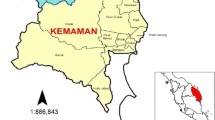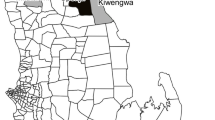Abstract
Aim
Knowledge, belief, attitude and values shape the health behaviour and all these can help in deciding whether to behave in one way or the other. Therefore, the underlying relationship between knowledge, attitude and practice (KAP) regarding causation, prevention and treatment of filarial disease is studied separately for affected and normal individuals.
Methods
KAP aspects of the disease were measured using a structured questionnaire and methods were designed to quantify all the variables for which data were collected. A salient feature of the method is the judicious assignment of scores to individual items and summing the scores across items for appropriate standardization.
Results
Multiple regression analyses indicate that the knowledge on disease treatment, mode of transmission, prevention and income explain about 29% of variation that occurs in knowledge on mosquito breeding and control. Standard of living, knowledge on disease transmission and knowledge on mosquito breeding and control explain 23% of variation in practice measures against mosquito biting. Knowledge gained on disease treatment, prevention, diagnosis and knowledge on mosquito breeding and control is greatly improving the prevention practices against mosquito breeding and control.
Interpretation
The results reveal that through imparting health education on disease prevention, diagnosis and treatment, awareness about mosquito breeding and control can be achieved.
Similar content being viewed by others
Notes
EDUINCOM=Number of years of schooling *Income
References
Bandyopadhyay L (1996) Lymphatic filariasis and the women of India. Soc Sci Med 42:1401–1410
Das PK, Manoharan A, Subramanian S, Ramaiah KD, Pani SP, Rajavel AR, Rajagopalan PK (1992) Bancroftian filariasis in Pondicherry, South India: epidemiological impact of recovery of vector population. Epidemiol Infect 108:483–493
Eberhard ML, Walker EM, Addiss DG, Lammie PJ (1996) A survey of knowledge, attitude, and perceptions (KAPs) of lymphatic filariasis, elephantiasis, and hydrocele among residents in an endemic area in Haiti. Am J Trop Med Hyg 54:299–303
Garrett HE, Woodworth RS (1961) The scaling of mental tests and other psychological data. In: Garrett HE (ed) Statistics in psychology and education. Longmans, London, pp 309–336
Hewlett BS, Kollo B, Cline BL (1996) Ivermectin distribution and the cultural context of forest onchocerciasis in South Province, Cameroon. Am J Trop Med Hyg 54:517–522
Kahn HA, Sempos CT (1989) Sample size calculation using odds ratio. In: Kahn HA, Sempos CT (eds) Statistical methods in epidemiology. Oxford University Press, New York, pp 64–71
Lu AG, Valencia LB, De Las Llagas L, Baltazar J, Cahanding ML (1983) The social aspect of Filariasis in the Philippines. Southeast Asian J Trop Med Public Health 14:40–46
Lu AG, Valencia LB, De Las Llagas L, Aballa L, Postrado L (1988) Filariasis: a study of knowledge, attitudes and practices of the people of Sorsogon. Social and Economic Research Project Reports No. 1. TDR/SER/PRS/1. WHO, Geneva
Manoharan A, Das PK, Keerthiseelan VB, Ramaiah KD (1997) Trend in Wuchereria bancrofti infection in Pondicherry urban agglomeration after withdrawal of a five-year vector control programme. J Commun Dis 29:255–261
Michael E, Bundy DAP (1997) Global mapping of lymphatic filariasis. Parasitol Today 13:472–476
Michael E, Bundy DAP, Grenfell BT (1996) Re-assessing the global prevalence and distribution of lymphatic filariasis. Parasitology 112:409–428
Michael E, Bundy DAP, Ottesen E, Ramachandran CP (1995) The global burden of lymphatic filariasis. In: Murray KS, Lopez AD (eds) The burden of disease. World Health Organization, Geneva
Directorate of Advertising and Visual Publicity (2000) National Health Policy. Government of India, New Delhi
Ottesen EA (2000) The global programme to eliminate lymphatic filariasis. Trop Med Int Health 5:591–594
Pani SP, Balakrishnan N, Srividya A, Bundy DAP, Grenfell BT (1991) Clinical epidemiology of bancroftian filariasis: effect of age and gender. Trans R Soc Trop Med Hyg 85:260–264
Ramaiah KD, Vijay Kumar KN, Ramu K (1996) Knowledge and beliefs about transmission, prevention and control of lymphatic filariasis in rural areas of South India. Trop Med Int Health 1(4):433–438
Rauyajin O, Kamthornwachara B (1991) Social and cultural aspects of filariasis prevention and its determinants in Nakorn-Srithammarat province, Southern Thailand. Unpublished manuscript. UNDP/World Bank/WHO Special Programme for Research and Training in Tropical Diseases (TDR). Grant No. 890569
Sabesan S, Palaniyandi M, Das PK, Michael E (2000) Mapping of lymphatic filariasis in India. Ann Trop Med Parasitol 94(6):591–606
Senathsien S (1991) Risk factors of filariasis, Wuchereria bancrofti in Mae-Ramat District, Tak Province. MSc thesis(unpublished), Chulalongkorn University, Thailand
Surendran K, Pani SP, Soudarssanane MB, Srinivasa DK, Bordolai PC, Subramanian S (1996) Natural history, trend of prevalence and spectrum of manifestations of Bancroftian filarial disease in Pondicherry (South India). Acta Trop 61:9–18
World Health Organization (1992) Lymphatic filariasis: the disease and its control. Fifth Report of the WHO Expert Committee on Filariasis. World Health Organ Tech Rep Ser 821:1–71
Acknowledgments
The authors are grateful to Dr. P. K. Das, Director, Vector Control Research Centre, and Pondicherry for his help and encouragement during the study. They acknowledge the health authorities of Pondicherry Government for their help and cooperation during the study.
Conflict of interest statement
The authors confirm that there are no relevant associations that might pose a conflict of interest.
Source of grant
Institutional Support (Vector Control Research Centre, Pondicherry, India).
Author information
Authors and Affiliations
Corresponding author
Rights and permissions
About this article
Cite this article
Perumal, V., Subbiah, G. A quantitative analysis of the socio-economic determinants of health seeking behaviour related to bancroftian filariasis and its impact on elimination: a case-control study in Pondicherry, India. J Public Health 16, 339–346 (2008). https://doi.org/10.1007/s10389-007-0172-7
Received:
Accepted:
Published:
Issue Date:
DOI: https://doi.org/10.1007/s10389-007-0172-7




